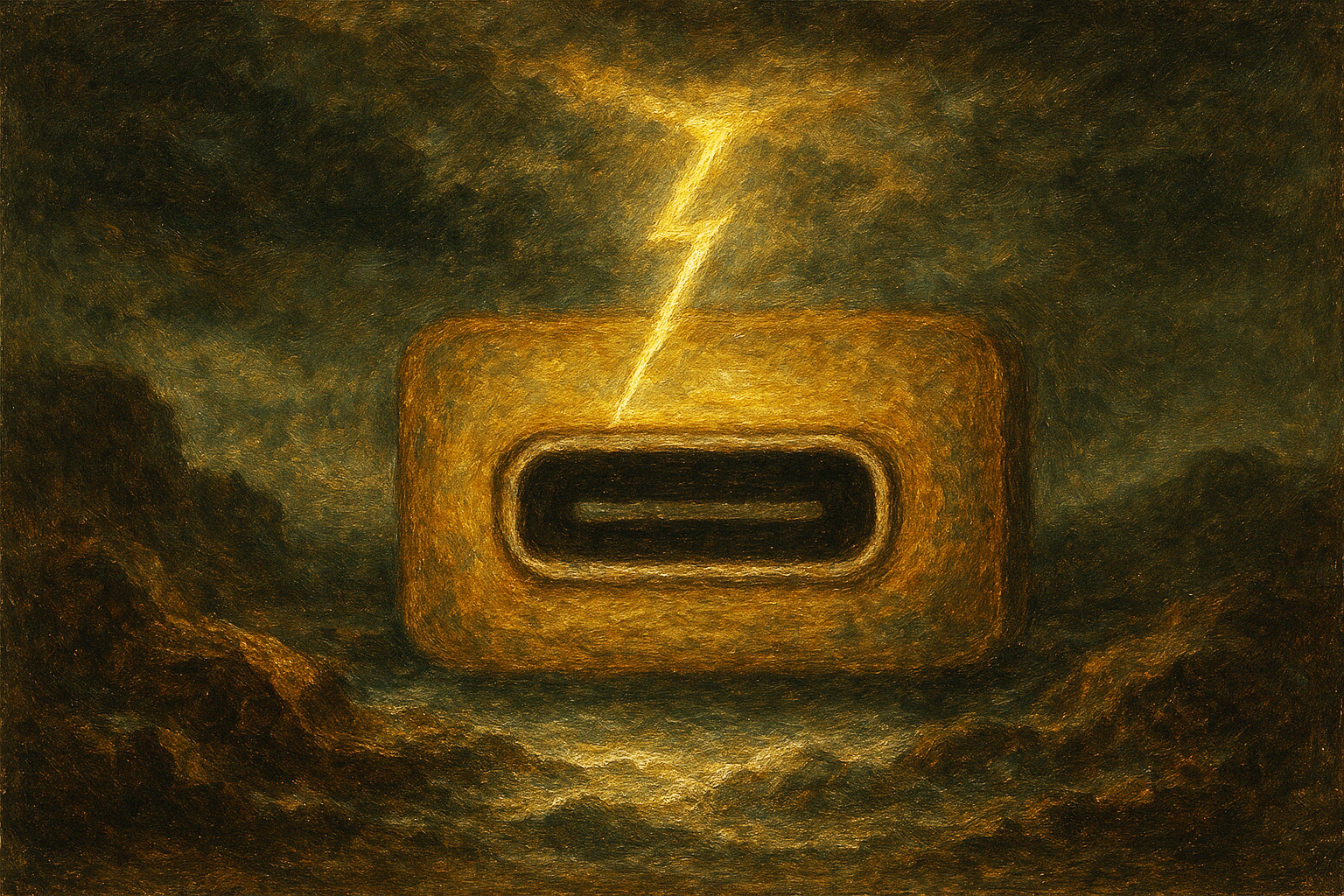Razer Blade vs. MacBook Pro: Face-Off
At first glance, the MacBook Pro 15-inch and the Razer Blade don't seem like rivals. After all, one is for creative pros, and the other is for gamers. But both of these big-screen notebooks pack a serious punch in a portable design. We pitted these powerhouses against each other in an eight-round battle to name a winner. So, which is it — the svelte, silver workhorse or the ebony, gaming badass?
Design
I've got to hand it to both Apple and Razer; they both know how to make a beautiful, iconic piece of machinery. On one hand, you have the MacBook Pro, whose silvery profile with rounded edges and backlit, half-eaten fruit emblem has launched a cadre of pale imitations.
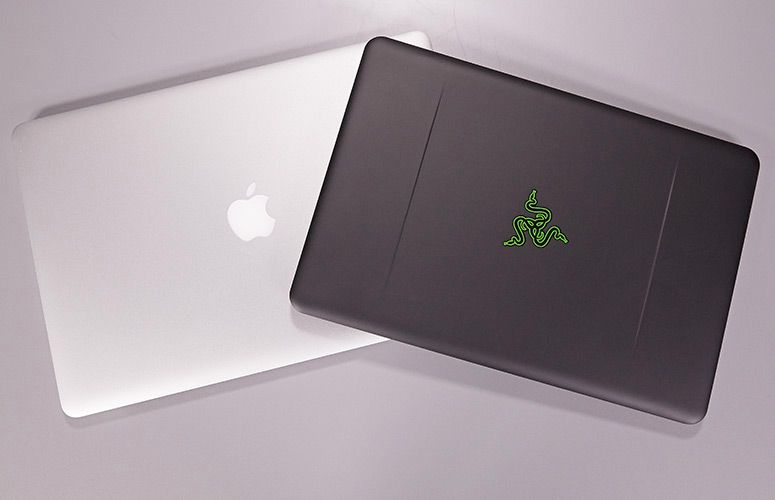
If not for its sable CNC-aluminum chassis and a couple of deliberate-but-subtle design choices, the Razer Blade would also fall into this clone trap. Outside of the color, the gentle ridges and captivating three-snake symbol on the lid do just enough to help the Blade stand on its own.
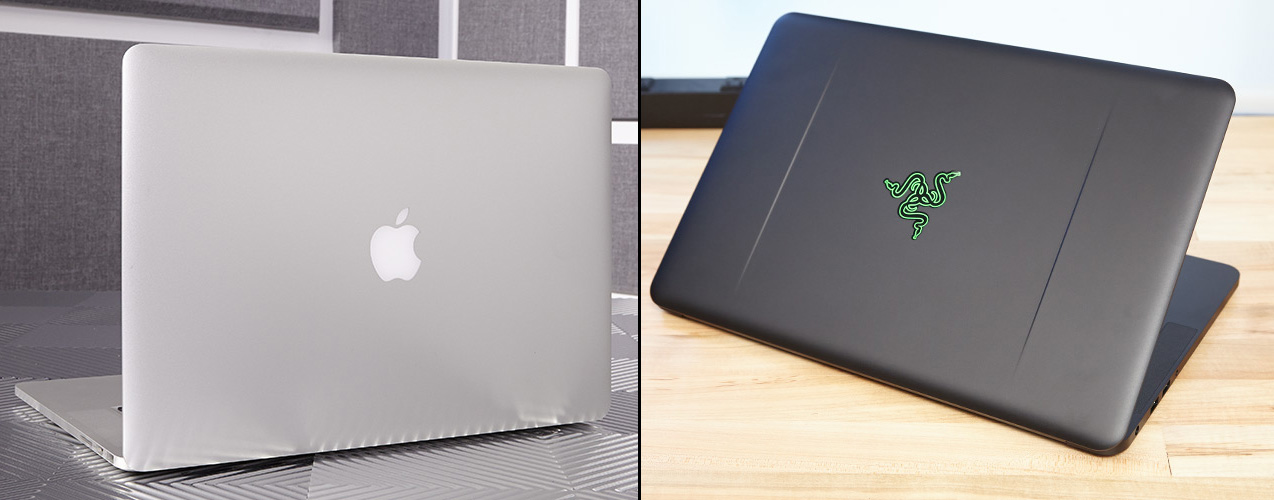
In terms of weight and dimensions, the Blade pulls out a slim win, at 4.25 pounds and 13.6 x 9.3 x 0.7 inches, compared with the MacBook Pro's 4.49-pound, 14.1 x 9.7 x 0.71-inch chassis.
Winner: Razer Blade. Razer's inky-black aluminum chassis just does it for me more than the minimalist, silvery vision that I've seen copied year after year. It also doesn't hurt that the Blade is slightly thinner and lighter than the MacBook Pro.
Ports
Stay in the know with Laptop Mag
Get our in-depth reviews, helpful tips, great deals, and the biggest news stories delivered to your inbox.
The MacBook Pro has a solid array of ports that can support a small army of peripherals, including a couple of 4K monitors if you're so inclined. The laptop features two USB 3.0 ports, an HDMI port, a SDXC card slot and a pair of Thunderbolt 2 ports, the latter of which allow you to perform superfast file transfers and connect to high-resolution external displays.
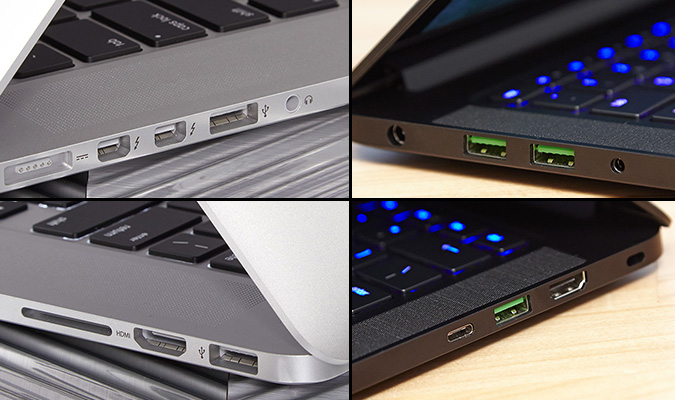
The Blade certainly doesn't lack ports and could support a modest gaming battle station. There are three USB 3.0 ports, an HDMI port and a USB Type-C port, which will allow gamers to hook the system up to Razer's new graphics amplifier, the Core, effectively transforming the lithe laptop into a formidable gaming desktop. However, the Razer lacks an SD card reader, which could turn off some people.
Winner: Razer Blade. Despite the conspicuously missing SD card, the Blade offers more ports than its Apple counterpart. Even better, the Razer's USB Type-C port can support all manner of gadgets, including Razer's own graphics amplifier.
Display
Apple's 15-inch Retina display (2560 x 1600) has become synonymous with bright colors and sharp detail — at least until it's placed next to the Blade. Boasting a beautiful 14-inch QHD+ (3200 x 1800) touch-screen panel, the Blade is a font of gorgeous color and elaborate detail.
MORE: The Best Gaming Laptops
When I watched the 4K "Tears of Steel" trailer, the reflective glare on one of the character's glasses was clear enough on the Blade that I could read a few words on the console he was watching. The neon green and magenta accents adorning various parts of the spaceship were much more vivid on the Blade than on the MacBook Pro.
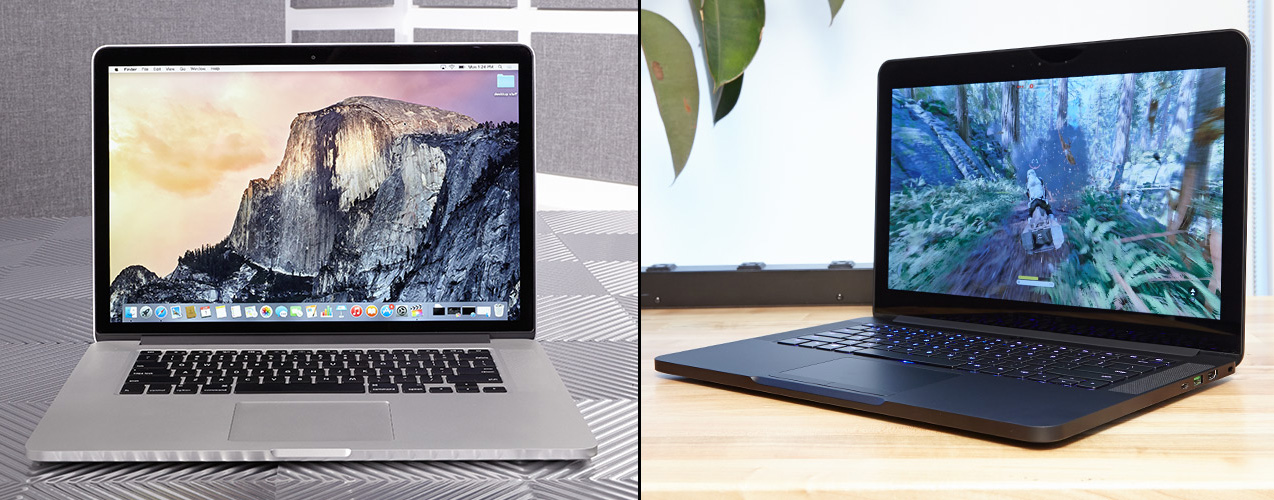
When we tested the two machines' color reproduction capabilities, the Blade's panel was off the charts, hitting 120 percent of the sRGB color gamut and topping the MacBook Pro's 86 percent. The Blade's display also exhibited strong color accuracy, scoring 0.95 on the Delta-E test (0 is ideal), compared with the MacBook Pro's inaccurate 2.1. The Blade continued its winning ways during the brightness test, averaging a dazzling 338 nits, compared with the MacBook Pro's 303 nits.
Winner: Razer Blade. The Blade's QHD+ panel is a trifecta of wins.
Keyboard and Touchpad
The MacBook Pro has the edge in typing comfort, offering more travel at 1.3 millimeters, compared with 1.1 mm on the Razer Blade.
However, the Blade's Chroma keyboard is simply a thing of beauty. The backlit keyboard not only supports 16.8 million colors, but it also can be augmented with one of six lighting effects. Thanks to the cloud-based Synapse software, gamers can record and map macros to any key on the keyboard as well as track their keystrokes to create a visual representation.
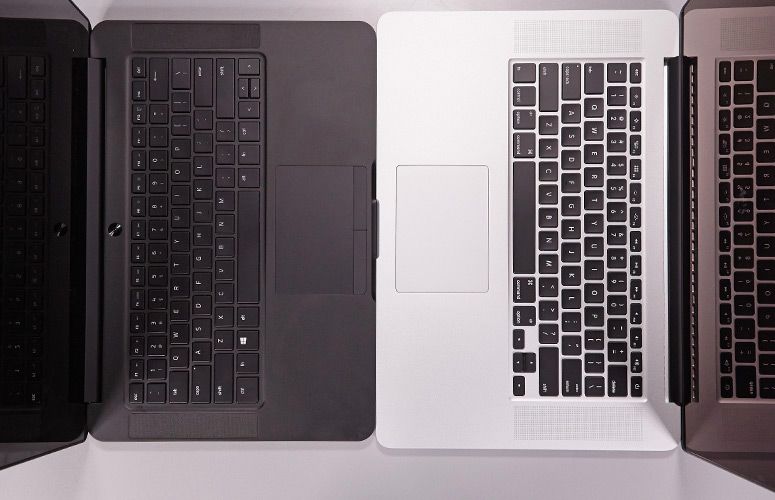
The MacBook Pro features the Force Touch trackpad. The pad uses force sensors and haptic feedback to create a Force Click, which performs special functions depending on how hard or quickly you press, instead of relying on the usual left and right clicks. It's a fun way to interact with your laptop, but it's kind of gimmicky.
Winner: Razer Blade. The Blade's Chroma keyboard wins here. You can customize the Blade's keyboard not only for aesthetics but useful functions for gaming and productivity.
Performance
The MacBook Pro is a lean, mean productivity machine.
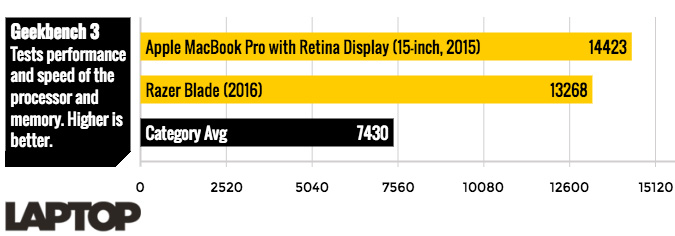
Despite being outfitted with a 4th-generation Intel Core i7 processor with 16GB of RAM, the laptop scored 14,423 on the synthetic Geekbench performance test. The Blade and its 6th-gen Intel Core i7 processor and 16GB managed only 13,268.
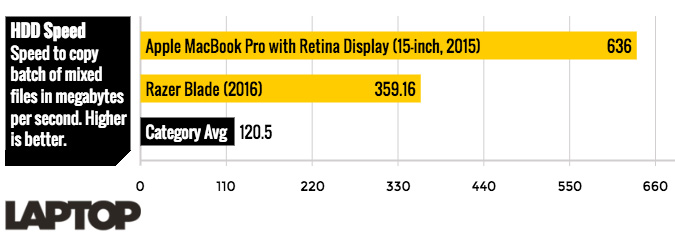
The MacBook Pro's 512GB PCIe-based flash storage kept up the pressure on the File Transfer test, delivering a transfer rate of 636 MBps. That scorches the Blade's 256GB PCIe solid-state drive, which hit 359.2 MBps. However, the Blade overtook the MacBook on the OpenOffice Spreadsheet Macro test, pairing 20,000 names and addresses in 3 minutes and 55 seconds, compared with 4 minutes and 14 seconds for the MacBook Pro.
Winner: MacBook Pro. Even with its older processor, Apple's notebook won two out of three tests.
Graphics
Just because a notebook has discrete graphics doesn't mean you're going to get a stellar gaming experience. When we ran the World of Warcraft benchmark on the MacBook Pro, its AMD Radeon R9 M370X GPU with 2GB of VRAM notched 40 frames per second at its native resolution of 2880 x 1800 on low. The Blade's Nvidia GeForce GTX 970M with 6GB of VRAM ran circles around that, playing at a steady 163 fps at 3200 x 1800.
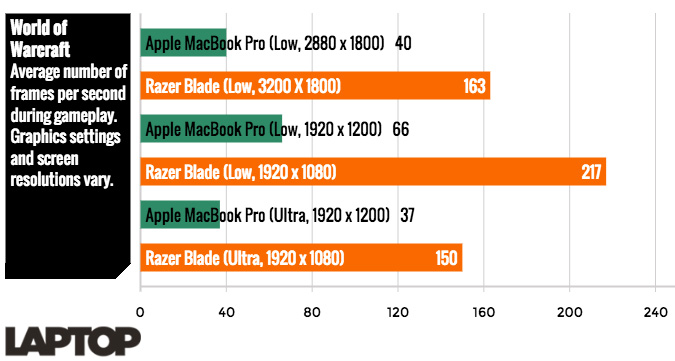
When we dropped the settings to 1080p, the Blade delivered an impressive 217 fps on low, soundly trouncing the MacBook Pro's 66 fps at 1920 x 1200. Once the settings were pushed to ultra, the Blade delivered 150 fps, while the MacBook Pro produced a still-playable 37 fps.
The Blade continued to wreak havoc, delivering a steady 58 fps at 3200 x 1800 on Dirt 3 on high. During the Tom Clancy’s Rainbow Six: Siege benchmark, the laptop produced 54 fps on low and 32 fps at the maximum setting.
Winner: Razer Blade. The MacBook Pro's AMD graphics run games at playable frame rates, but its output is nowhere near the Blade's.
Battery Life
When it comes to battery life, the MacBook Pro reigns supreme.
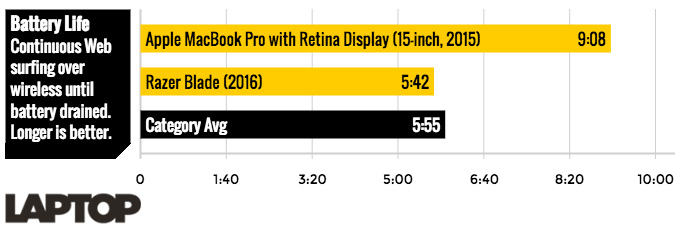
MORE: Laptops with the Longest Battery Life
The laptop lasted a whopping 9 hours and 8 minutes on our battery test (continuous web surfing over Wi-Fi). In contrast, the Blade tapped out 5 hours and 42 minutes, which is respectable for a gaming laptop but nowhere near Apple's notebook.
Winner: MacBook Pro. It's no contest.
Value
Both systems have a starting price of $1,999. On the MacBook Pro, that gets you an Intel Core i7 GPU with 16GB of RAM, a 256GB PCIe-based flash storage and Intel Iris Pro Graphics. The Blade packs an Intel Core i7 GPU with 16GB of RAM, a 256GB PCIe SSD and a Nvidia GeForce GTX 970M with 6GB of VRAM.
The price jumps significantly when you double the storage to 512GB for both laptops. The Blade's price rises to $2,199, while the MacBook's price leaps to $2,499. However, in the case of the MacBook Pro, you'll make the jump to discrete graphics with an AMD Radeon R9 M370X with 2GB of VRAM.
Winner: Razer Blade. Getting discrete graphics in the starting configuration made all the difference.
Overall Winner: Razer Blade
The Razer Blade wins this contest six rounds to two, making it the best overall choice, but the MacBook Pro 15-inch is no slouch.
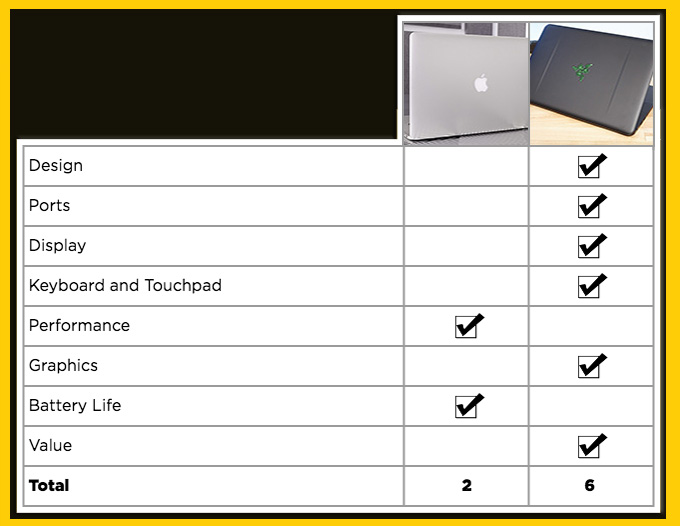
When it comes to offering the best combo of productivity and endurance, the MacBook Pro is hard to beat. The notebook offers over 9 hours of battery life, a powerful processor, a lovely Retina display and the innovative (though maybe not totally necessary) Force Touch trackpad in Apple's often-imitated-but-never-duplicated design. However, having to shell out $2,499 for a discrete graphics card is a bit much to ask, especially when gamers and creative professionals can get the Razer Blade for $1,999.
With the Blade, you get a stunning QHD+ display, a highly customizable keyboard and solid performance with wicked graphics. Plus, you can transform the Blade into an even more powerful system with the optional Razer Core and a desktop graphics card. As a gamer and a responsible working adult, I want the Razer Blade so I can transition from work to play without batting an eye.

Sherri L. Smith has been cranking out product reviews for Laptopmag.com since 2011. In that time, she's reviewed more than her share of laptops, tablets, smartphones and everything in between. The resident gamer and audio junkie, Sherri was previously a managing editor for Black Web 2.0 and contributed to BET.Com and Popgadget.
